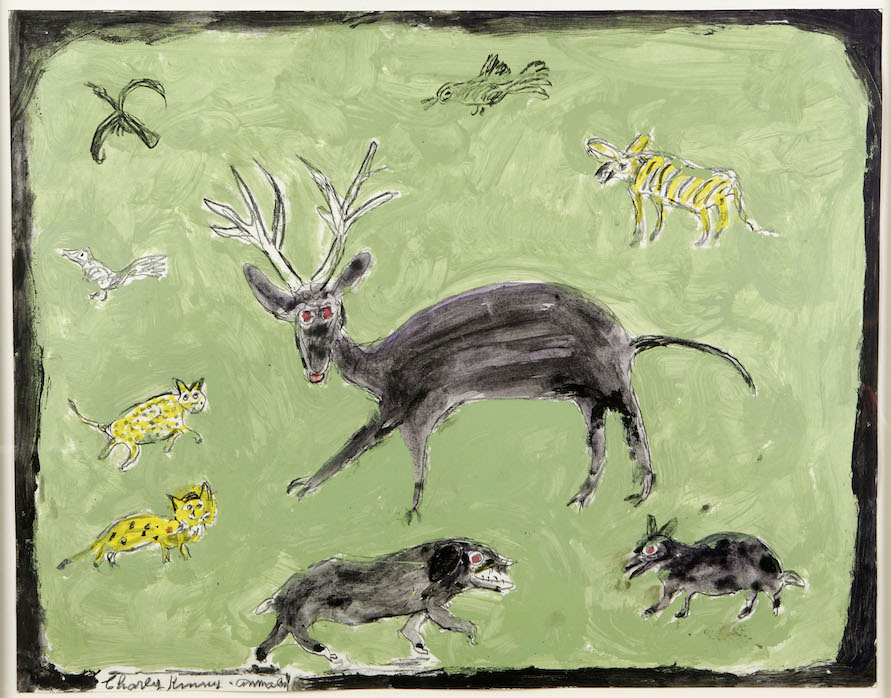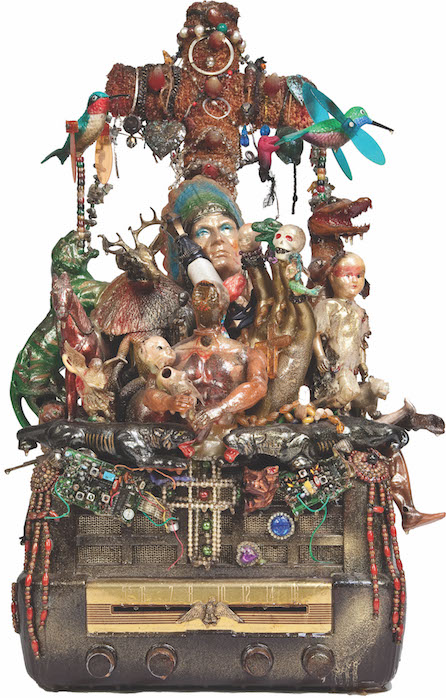Cover photo: The Devil is Always Trying to Close the Gate (#1), by LaVon Williams
Supporters of Kentucky folk art are bewildered by the lack of a concrete plan to save the celebrated Kentucky Folk Art Center in Morehead, the only art museum in Kentucky’s 54 Appalachian counties.
 Bird Watching, by Jo Neace Krause |
The three-decade-old center with 1,407 works by Kentucky artists — many of whom have pieces in the Smithsonian — is a victim of state funding cuts and Morehead State University cutbacks. But despite early promises by museum owner MSU to save what the Christian Science Monitor called a “Rosetta Stone” for understanding the evolution of folk art, few are satisfied with efforts thus far.
“I get so angry when I even think of it,” said folk art dealer Larry Hackley, a Madison County resident who has curated exhibitions at the museum. “They’re not thinking of the long-term ramifications of shutting this down.”
The museum’s troubles began in 2016 when MSU, plagued with its own budget problems, eliminated its $100,000 in support for the museum it owns. This year, the situation worsened dramatically when the state eliminated the rest of the museum’s funding — the state’s annual $200,000 appropriation to the museum.
Museum supporters are frustrated by what they perceive as the university’s lack of leadership in the crisis. Museum advisory board co-chair Barry Crume said University President Joseph “Jay” Morgan “is not taking responsibility or leadership at all. It’s very sad.” Morgan is relatively new to the 10,500-student campus, taking the reins at MSU in March 2017 following Wayne Andrews’ retirement.
Early hopes to stave off a crisis vanished when a strategic plan to save the museum, devised by the museum’s advisory board and submitted to the university at its request, was shelved without explanation or discussion. Museum Director Matt Douglas Collinsworth said he was told that “based on where things are right now, the strategic plan is not up for consideration. It’s defunct.”

Museum Director Matt Douglas Collinsworth with artwork by LaVon Williams // by Joey Harrison
Initially, Collinsworth and others believed a commitment President Andrews made in 2016 might play an important role in the museum’s salvation. At that time, Andrews wrote that the university pledged to either support a fully functioning museum or, if MSU was incapable of carrying the burden, it would help find a new home for the museum. One option would be to allow the folk art center to operate independently.
“I think we could raise enough money to keep operating the museum as an independent entity,” Collinsworth said. “But I don’t know if we could do that while we’re still located in Morehead.” Collinsworth has a strong record in grantsmanship, bringing many successful grants to the museum and, in his previous role with the Morehead downtown redevelopment, attracting several million dollars in grant funding to the city.

Artwork by Bruce New
But as long as the museum is attached to the university, his fundraising options are limited. “I can’t go over to the bank and say, ‘Hey, will you guys sponsor our exhibition.’” Such a plea would interfere with the university’s corporate fundraising efforts. But even with those strictures, Collinsworth was able to raise nearly $100,000 in donations in 2017.
President Morgan doesn’t think MSU can let go of the collection, saying “intricacies” of “how the building was refurbished and how the artworks are donated [to the university] and are loaned to the museum” could prevent it. “It’s a complicated equation,” Morgan said, although he acknowledged, “I have not spent a lot of time digging down into it.”

Wild Animals, by Charles Kinney
Community members and museum supporters are mystified by the state of affairs. In May two advisory board members, co-chair Josephine D’Amato Richardson of Whitesburg and Crume, came away dumbfounded from a meeting with Morgan.
“He says he wants to keep [the museum] in Morehead,” Richardson said. “He wants to bring the collection and distribute it throughout the campus to decorate buildings with. It’s like he thinks this is Michael’s or Hobby Lobby. I’m being painfully honest with you. He repeated that a number of times.”
Crume called the plan “horrible. It’s absolutely horrible.”
“The museum collection as a whole is extremely important to Kentucky history of self-taught artists in Appalachia. It’s not a decorative arts museum,” he said.
Board members are disappointed by what they characterized as a lack of innovation and leadership by the university president. “He did not provide a solution,” Crume said. “He’s the president of MSU, and MSU owns the collection. In my opinion he should say, this is important. Here’s how we’re going to keep it open… He didn’t do that.”
In my conversations with him, Morgan acknowledged that using the collection as decoration was “probably not the most desired thing to do.” Instead, he suggested the collection could be moved to the university’s single gallery, which is used for student artwork and traveling art exhibitions. Morgan said the 1,400 pieces in the folk art collection could be shown on rotation with other exhibits. But Morgan’s principal hope was to find community partners to help keep the museum alive – even if only on life support. He has asked the city of Morehead, the Morehead Tourism Commission and Rowan County to each kick in $25,000 to keep the doors open. But he could not say how much the university would add to that $75,000 pot – an omission that appears to be undermining even this modest plan.
“It’s been very confusing,” said Keith Kappes, chair of the Morehead Tourism Commission. He said his own board is unwilling to support the museum without solid assurance of MSU’s strong support. “There’s been a lot of platitudes, Oh yes, we want it! We need it! It’s important to us! But we haven’t seen the hard cash to support it. I’m frustrated myself. I’m just tired of the ya-ya-ya-ing.”

Wood sculptures by LaVon Williams
Morgan told me he couldn’t provide a specific dollar amount for the university’s contribution. “There are so many equations,” he said. “If the city and county budgets are willing to chip in starting Day 1, we don’t have to use as much of our reserves to put toward the center. If we have to wait four, five, six months, that would limit how much the university would put forward.”
Even if all three entities agree to support the museum – which looks doubtful at the moment – the funding level doesn’t go halfway toward restoring what the museum once was. Before the state cuts, the $300,000 in state and university funding provided a staff of five, including – most critically – a curator. With that level of staffing, Collinsworth was able to apply for grants to further support the collection, often pushing funding near $500,000 annually. As a result, the museum supported an educational program that touched up to 24,000 Kentucky students a year. It put on one major show a year and produced a scholarly catalog about the featured art works. Those shows traveled to museums around the country.
But once the university stopped funding the curator position in 2016, and Collinsworth was forced to add the role of curator to his job description, the Folk Art Center was no longer a serious contender for grants. “Without a curator, I’m not going to get funded,” Collinsworth said. In August, the university dealt a further blow when it put the center’s education coordinator to work on campus, severely limiting student outreach.
 Son of Crocodile Boy, by Robert Morgan |
MSU, in the meantime, has financial problems of its own. Its $40 million in state funding was cut by just under $3 million for the budget year that begins July 1. MSU lost another $1 million when the number of Saudi Arabian students declined sharply. Overall enrollment has been falling annually by more than 2-2.5 percent a year for seven or eight years, although Morgan projected generally stable enrollment for the coming academic year.
In the last three years, the university completed several high-dollar construction projects including a $17.6 million parking and dining building; a $28 million residence hall with space for 550 students – the first housing built since 1969; and, two new 48-bed residence halls costing $2.7 million. In addition, MSU is undertaking a $49.5 million state-funded renovation of the Adron Doran University Center, doubling its size and creating restaurant-style accommodations.



